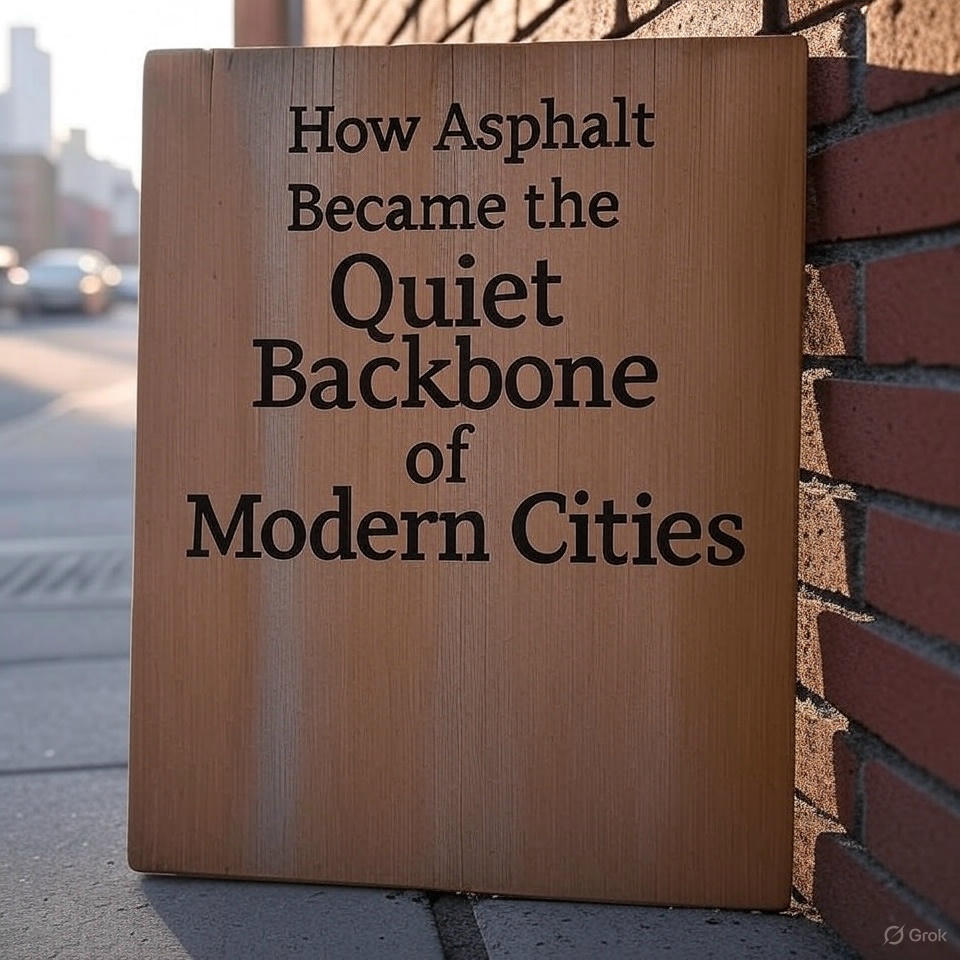The Black Ribbon: How Asphalt Became the Quiet Backbone of Modern Cities

We go on it, drive over it and build our daily life around it – just a few break to consider asphalt paving as a little more than a practical surface. But this black, smooth material is much more than a basis for roads. It is a cultural thread, a technological breakthrough and an invisible force that has been redefined how cities breathe and work.
Asphalt rise of primitive tar paths to today’s extensive motorway systems reflects the growth of human ambition. This is the story of a material that not only supported progress – it has led it quietly.
Origins under the dust: from old mixtures to modern asphalt
Early foundations in old civilizations
While asphalt paving feels modern, its origins extend far into the past. The old mesopotamians used natural bitumen – a sticky shape of the oil – to bind waterproof channels and bricks. The Romans also used primitive paving stones to build military roads that connected their empire.
But asphalt in its sophisticated urban form would only arrive centuries later when the march of industry demanded more than cobblestones.
Industrial age and the birth of black roads
In the 19th century, cities in Europe and North America swell of people and vehicles. Dirt roads turned into sludge flows and stone plants could not cope with the pressure. Enter asphalt.
Edwin de Smedt, a Belgian American, will be attributed to the introduction of modern asphalt paves for the USA in the 1870s.
The dark side: if the progress is paving about problems
Heat islands and environmental compromise times
Although asphalt revolutionized the cities, it also brought challenges. Asphalt absorbs warmth and contributes to the municipal Heat Island effect, especially in cities with little green. It is not breathable like soil, and the drainage of paved surfaces can emphasize local waterways.
Environmentalists today ask how cities can harmonize the infrastructure with sustainability, and asphalt is often the focus of this debate.
Maintenance, aging and urban decay
Asphalt does not last forever. Cracks, potholes and fading lines signal neglect. In some municipalities, a deterioration in the sidewalk becomes a visual memory of inequality, in which some streets are quickly repaired, while others can be expelled.
Asphalt shows, although it is neutral in appearance, often unspoken truths about politics, power and investment.
Urban rhythms rewritten: asphalt cultural imprint
From chaos to order: organization of the city flow
Cities were chaotic before asphalt. Horses stumbled on cobblestones. Carries collapse. Rain converted streets into mud. But the city changed as a smooth asphalt.
The traffic flowed more efficiently. Deliveries arrived faster. Commuters became bearable. Whole districts organized the predictability of a black band that promised progress.
The sound of silence: how asphalt cities calmed down
Asphalt did something unexpected – it was silent to silence cities. Compared to the loud rattling of wheels on stone, rubber tires, which slide over asphalt, calmly. This change has the way people have perceived city life. Bürgersteigcafés, libraries and calm parts of the city flourished thanks to a paving solution that connected the chaos.
A canvas for design: asphalt as an architectural element
Invisible, however, intends: street planning and asphalt grille
The modern urban design depends heavily on asphalt. City planners use it to draw boundaries, create traffic flow and define neighborhoods. Streets no longer combine – it shape.
Los Angeles’s layout with its endless grille from Blackop or Paris, in which curved boulevards lead the traffic with elegance, shows how asphalt was a basic design tool, N, t just a surface.
The asphalt palette: symbolism and city identity
Think of Wall Street, Sunset Boulevard or Route 66. These streets are not just transport tools – they are cultural icons. Asphalt is not striking, but it keeps identity. The cracked black of a forgotten street, the fresh seal of a new one – these small changes tell stories about investments, neglect or renewal.
New streets ahead: Develop visions for asphalt use
Innovations in environmentally friendly asphalt
The paving industry continues to develop. The researchers develop warmmix asphalt, recycled plasters and permeable surfaces that allow it to enforce water. Some cities even experiment with a solar panel-integrated asphalt to create performance.
These innovations indicate a future in which the BlackPop is not only a backdrop, but also to the solution of environmental problems.
Rec defect mobility and city life
Asphalt is implemented with walk -in cities, bike paths and intelligent roads. Instead of expanding motorways, many cities can recapture the road area for the use of the community and transform old parking spaces into green parks or places.
In this way, asphalt is no longer just about cars. It is about options – and how space can be redefined for the connection, not just for the transit.
Conculsion
It is easy to overlook asphalt. It mixes into the background. It is not glamorous. But take it away and stall a city.
Asphalt paving gave the way we move, how we plan and even the way we dream. It is more than material – it is memory, connection and the basis. While his role can develop over time, his legacy is sealed in every street in which we go.
Frequently asked questions
1. What does asphalt pavement exist? Asphalt paving mainly consists of a mixture of bitumen (an oil product) and aggregates such as sand, gravel or crushed rock. This combination creates a durable and flexible surface that is suitable for roads and highways.
2. Why is asphalt in cities preferred to concrete? Asphalt is usually quieter, faster and cheaper than concrete. Its flexibility also makes it better for areas with temperature fluctuations or strong traffic loads.
3 .. Does asphalt paving do the environment damage? While asphalt has environmentally related disadvantages, such as heating islands, newer techniques such as recycled asphalt and permeable walkways aim to reduce ecological footprint.
4. How often do streets need repaving? This depends on traffic levels and weather, but most asphalt roads require a repetition every 10 to 15 years.





